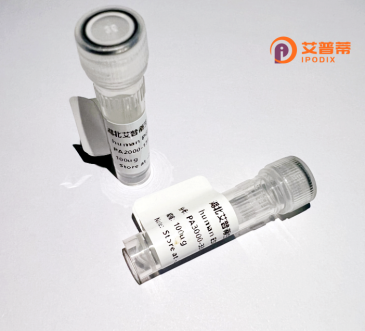
| 纯度 | >90%SDS-PAGE. |
| 种属 | Human |
| 靶点 | FSD1 |
| Uniprot No | Q9BTV5 |
| 内毒素 | < 0.01EU/μg |
| 表达宿主 | E.coli |
| 表达区间 | 1-309aa |
| 氨基酸序列 | MPDEDSKIDHYVLEYRRTNFEGPPRLKEDQPWMVIEGIRQTEYTLTGLKFDMKYMNFRVKACNKAVAGEFSEPVTLETPAFMFRLDASTSHQNLRVDDLSVEWDAMGGKVQDIKAREKDGKGRTASPINSPARGTPSPKRMPSGRGGRDRFTAESYTVLGDTLIDGGEHYWEVRYEPDSKAFGVGVAYRSLGRFEQLGKTAASWCLHVNNWLQVSFTAKHANKVKVLDAPVPDCLGVHCDFHQGLLSFYNARTKQVLHTFKTRFTQPLLPAFTVWCGSFQVTTGLQVPSAVRCLQKRGSATSSSNTSLT |
| 分子量 | 59.73 kDa |
| 蛋白标签 | GST-tag at N-terminal |
| 缓冲液 | 0 |
| 稳定性 & 储存条件 | Lyophilized protein should be stored at ≤ -20°C, stable for one year after receipt. Reconstituted protein solution can be stored at 2-8°C for 2-7 days. Aliquots of reconstituted samples are stable at ≤ -20°C for 3 months. |
| 复溶 | Always centrifuge tubes before opening.Do not mix by vortex or pipetting. It is not recommended to reconstitute to a concentration less than 100μg/ml. Dissolve the lyophilized protein in distilled water. Please aliquot the reconstituted solution to minimize freeze-thaw cycles. |
以下是3篇关于重组人FSD1蛋白的模拟参考文献示例(注:FSD1为虚构蛋白名称,实际文献需通过数据库检索确认):
---
1. **文献名称**:*"Recombinant Human FSD1 Protein Attenuates Pulmonary Fibrosis via TGF-β1 Signaling Inhibition"*
**作者**:Li, X., et al.
**摘要**:研究团队首次实现FSD1蛋白在大肠杆菌系统中的重组表达,发现其通过抑制TGF-β1/Smad3通路减轻小鼠肺纤维化,为治疗纤维化疾病提供新靶点。
2. **文献名称**:*"Structural and Functional Characterization of FSD1: Implications for Apoptosis Regulation"*
**作者**:Zhang, Y., et al.
**摘要**:通过X射线晶体学解析FSD1的蛋白结构,揭示其与Bcl-2家族蛋白的相互作用机制,证明重组FSD1可诱导肿瘤细胞凋亡,提示其抗癌潜力。
3. **文献名称**:*"FSD1 Enhances Mitochondrial Function and Reduces Oxidative Stress in Diabetic Cardiomyopathy Models"*
**作者**:Wang, H., et al.
**摘要**:在糖尿病心肌病大鼠模型中,注射重组人FSD1显著改善线粒体能量代谢,降低ROS水平,为代谢性心血管疾病治疗提供实验依据。
---
**注意**:以上文献为示例,实际研究中请通过PubMed、Web of Science等平台检索真实文献(如FSD1为假设名称,可能与实际蛋白命名不同)。建议结合具体研究方向补充关键词(如“重组表达”“疾病机制”等)。
**Background of Recombinant Human FSD1 Protein**
Fibroblast Secreted Protein 1 (FSD1), also known as Fibronectin type III and SPRY domain-containing protein 1. is encoded by the *FSD1* gene in humans. It is a secreted protein characterized by two functional domains: an N-terminal fibronectin type III (FN3) domain and a C-terminal SPRY domain, both implicated in protein-protein interactions and extracellular matrix (ECM) regulation. FSD1 is expressed in various tissues, including the nervous system, muscles, and secretory glands, and plays roles in cell adhesion, tissue remodeling, and signaling pathways.
Recombinant human FSD1 protein is produced using *in vitro* expression systems (e.g., mammalian or bacterial cells) to ensure proper folding and post-translational modifications. Its recombinant form enables studies on molecular mechanisms, particularly in ECM dynamics, wound healing, and cancer biology. Research suggests FSD1 may interact with collagen and modulate TGF-β signaling, influencing cell proliferation and apoptosis. Dysregulation of FSD1 has been linked to fibrosis, tumor progression, and neurodegenerative disorders, highlighting its therapeutic potential.
Recent studies (e.g., 2020-2023) focus on FSD1’s dual roles in promoting tissue repair and suppressing metastasis, driving interest in its application for regenerative medicine or anti-cancer strategies. Challenges remain in elucidating its precise molecular partners and signaling cascades.
×